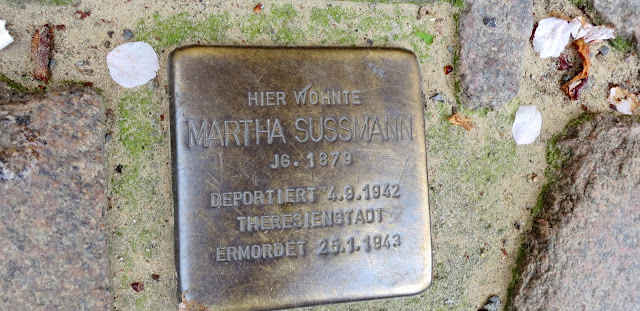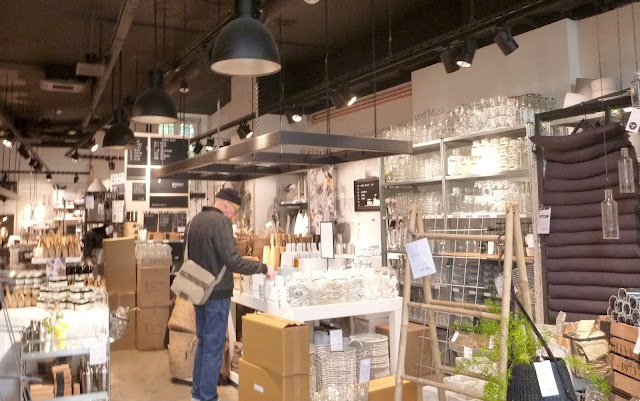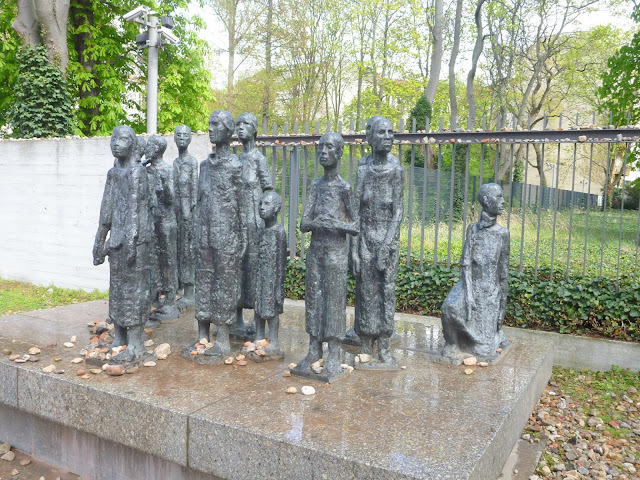We had a wonderful time in Berlin, despite the weather which was extremely disappointing: it snowed during our first full day in the city, and the rest of the time (with the exception of our last day) it rained and rained, with bright spells of sunshine in-between. We still managed to make the most of our stay, and miss this wonderful, vibrant city a lot.
We stayed in the Spandauer Vorstadt, the heart of Mitte, the most central borough of the city. Today, Spandauer Vorstadt serves as Berlin's primary 'downtown'. Before the war this was the city's Jewish quarter and by the start of the 20th century the district had become the cultural and spiritual centre of a well-established, wealthy and influential Jewish community. Things changed dramatically under the Nazis, but after the Wende, the Spandauer underwent a dramatic revival. Squatters and artists were the first pioneers; restoration projects soon followed, renovating the backstreets to usher in a tide of bars, boutiques and restaurants.
The Circus Hotel is where we stayed during our first visit to the city seven years ago. It's a cool, trendy place and is extremely comfortable and efficiently run.
Across Rosenthaler Platz is the Circus hostel
We got an upgrade for the princely sum of 10 euros this time and stayed here, the Circus apartments, in a large, minimalist, fully equipped apartment which was quiet, comfortable and luxurious
located in a pleasant residential area.
We visited this park that was near our hotel a few times

and enjoyed looking at this sculpture
Martha Sussmann, taken to Teresienstadt concentration camp, 1943
The area's Jewish history is evident throughout the district, not least by the Stopersteine that if you pay attention, can be found everywhere. A stolperstein, means a stumbling stone, metaphorically a stumbling block, or a stone to stumble upon. They are 10x10 cm concrete cubes bearing a brass plate inscribed with the name and life dates of victims of Nazi extermination or persecution. An art project, initiated by the German artist Gunter Demnig in 1992, which is still ongoing, it aims to commemorate individual persons at exactly the last place of residency - or sometimes, work - which was freely chosen by the persons before s/he fell victim to Nazi terror, euthanasia, was deported to a concentration or extermination camp, or escaped persecution by emigration or suicide. As of 31 January 2017, over 56,000 stopersteine have been laid in 22 European countries, making this the world's largest decentralised memorial. The majority commemorate Jewish victims of the Holocaust, but others have been placed for Sinti and Romani people, homosexuals, Jehovah's Witnesses, black people and other groups that the Nazis exterminated.
There are a lot of vintage shops in the area,
as well as quirky shops, like this one which is an Antiquarian cookery book seller.
Weinbergsweg was a two-minute walk from our apartment and it's full of restaurants - this is where we ate most evenings as the selection of restaurants was impressive, not just with German food, but Vietnamese, Japanese, Italian and Russian.

Rosenthaler Strasse is one of the main avenues that runs through the district, and we enjoyed walking here,
as it's full of interesting shops.

We were pleased to come across Granite, which we had last seen in Stockholm
it sells household items
Swedish-style.

Oskar and Max Metzger, father and son, I presume, taken in 1938, to Lemberg Ghetto and Bentsohen/Zbaszyn where they both died.
Sophienkirche on Sophien Strasse. Unfortunately it was closed so could not go in.
James Deutsch, taken to Sachsenhausen, and Johanna Klum, taken to Auschwitz in 1943.
Wishful thinking...
Posters we saw in a nearby courtyard
The Jewish cemetery on Grosse Hamburger Strasse, is the oldest in Berlin, established in 1672. Here also stood the first old people's home to be founded in the city. The Nazis used the building as a detention centre for Jews and 55,000 people were held here before being deported to the camps.
Pebbles have been placed on the outer wall of the cemetery and on the railings.
A sculpture of haggard-looking figures representing deportees
In 1943 the Gestapo smashed most of the headstones and dug up the remains of those buried here, using gravestones to shore up a trench they had excavated through the site. It's a grassed-over open space now

except for a few cracked headstones with Hebrew inscriptions that line the graveyard walls.
The only freestanding headstone was erected after the war to commemorate Moses Mendelssohn, the philosopher and German Enlightenment figure.
As with every Jewish monument or building we visited, CCTV cameras were to be found everywhere
and police were guarding the site - a sad reflection of the continuing threat to Jewish people and institutions.
Leo and Flora Aronsbach, husband and wife I presume, taken to Auschwitz in 1943.
This made us smile....

On Auguststrasse,

two galleries of contemporary art - Me Collectors Room was closed as they were preparing for the next exhibition
and KW Institute for Contemporary art, which we visited.

Alice and Gertruo Rosenberg, mother and son I presume, taken to Auschwitz in 1942, and Eli and Rosa Schneller, husband and wife? taken to Auschwitz in 1943.
During the initial waves of Jewish immigration from the 17th century onwards the area around Oranienburger Strasse was a densely populated and desperately poor ghetto, but by the 19th century Berlin's Jews had achieved a high degree of prosperity and assimilation. This was reflected in the building of the Neue Synagogue, designed by Eduard Knoblauch. It was Berlin's central synagogue for more than 60 years.
It did not survive the Third Reich. It was damaged during Kristallnacht though it was not destroyed thanks to the intervention of the local police chief who chased off the arsonists and called the fire brigade to extinguish the flames. It remained in use as a place of worship until 1940 when it was handed over to the Wehrmacht, who used it as a warehouse until it was gutted by bombs on the night of November 22, 1943. In 1988 work began to resurrect the shell and in 1995 the building was reopened as a museum and cultural centre.
Heavy police presence here as well.
Erika and Meta Haitner, sisters? both taken to Auschwitz in 1942

By Hackescher Markt train station
we came upon an open-air market on Thursday, our last day
a Sahlep (a drink made out of orchid flowers) seller
handmade chocolates
flowers
fruit and veg
including the huge, white asparagus that were in season and which are delicious
cooked food
pizzas that are baked in the oven while you wait.













































No comments:
Post a Comment